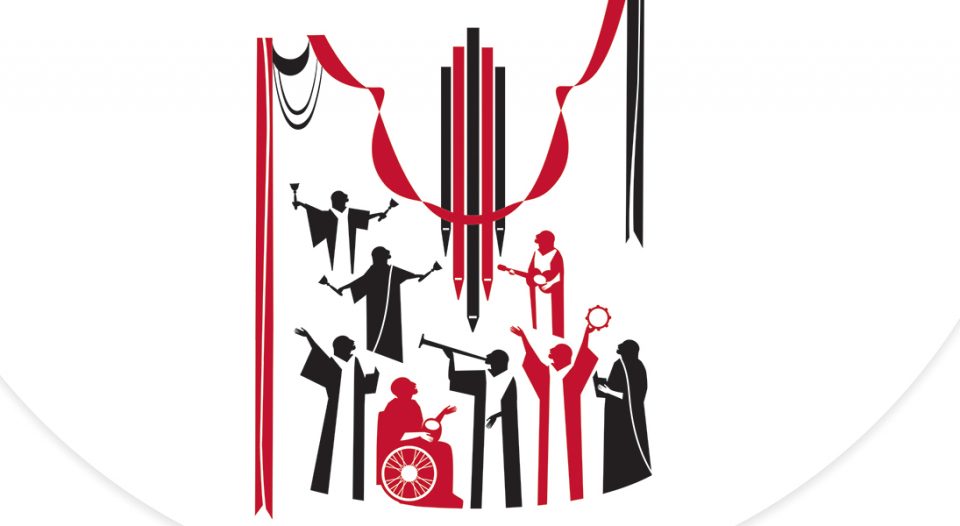Editor’s note: Martin Luther famously said, “Next to the Word of God, music deserves the highest praise” (Luther’s Works, Vol. 53). The ELCA still holds tightly to Luther’s understanding. In this six-part series, we’re exploring Lutheran music throughout history, the importance of music to the Lutheran faith and how that tradition continues today across styles and expressions.
In the sanctuary of Central Lutheran Church in Minneapolis, where I serve as cantor, we have a constant physical reminder of the origins and geographical blossoming of Martin Luther’s Reformation.
At the center of each of the stained-glass windows that ring the ground floor of the sanctuary, a flag or coat of arms is displayed. Standing at the altar, the progression moves from left to right beginning with the banner of Wittenberg, then the coat of arms of Saxony followed by the flags of the Nordic countries, and so on up to the flags of Canada and the United States. Over the past two years, a building renewal project has created space for an additional window.
After some discussion it was decided that the new window would display the flag of South Sudan—a place where the Lutheran church is growing rapidly.
When the project is complete, you will be able to stand in the nave and, viewing the windows, contemplate the growth and influence the churches of Africa, Latin America and Asia now have on those of Europe and North America.
One of Luther’s greatest gifts to his followers—to us—is his insistence that the proclamation of the gospel be given back to the people through congregational song. Over centuries our repertoire has expanded as Reformation-era chorales were joined by metrical paraphrases of Psalms; newly composed hymn texts and tunes; hymns born out of historic movements (Methodist, Oxford); ancient hymns translated into new, fresh language; and so on.
Globally in churches where European and North American missionaries were active, where congregational song was largely dependent on translations of Western hymns, indigenous poets and composers came to find their voices, creating hymns and songs using their own textual imagery and musical traditions.
The riches we have available to us from global communities are too numerous to count, each with a particular musical flavor and often refreshingly insightful language.
Thanks to the work of pastors, musicians and teachers (many from the ELCA’s predecessor church bodies), these songs have become part of the worship life of ELCA congregations through their inclusion in Evangelical Lutheran Worship (ELW). An example is Howard Olson, who, during the many years he taught at Tumaini University Makumira in Arusha, Tanzania, became familiar with the vast treasury of songs from the churches of East Africa. His translations and musical transcriptions have given us “Christ Has Arisen, Alleluia” (ELW, 364), “Gracious Spirit, Heed Our Pleading” (ELW, 401) and “Listen, God Is Calling” (ELW, 513).
Born to missionary parents in Madagascar, Gerhard Cartford—an alumnus of several institutions including St. Olaf College, Northfield, Minn.; Union Theological Seminary, New York City; and Luther Seminary, St. Paul, Minn.—spent several years working with churches in Latin America. He not only collected, edited, arranged and translated hymns and songs from Latino traditions, he also wrote and collaborated with composers to create new pieces for worship. “The Lord Now Sends Us Forth” (ELW, 538), “O Sing to the Lord” (ELW, 822) and “Yours, Lord, Is the Glory” (ELW, 849) are all the work of this pastor, musician and scholar.
The riches we have available to us from global communities are too numerous to count, each with a particular musical flavor and often refreshingly insightful language. The invigorating samba of Per Harling’s “You Are Holy” (ELW, 525), the traditional African call-and-response structure of “Come, Let Us Eat” (ELW, 491) and Moises Andrade’s text of the Filipino hymn “When Twilight Comes” (ELW, 566), which compares God’s love to that of a mother hen gathering her chicks, augment the repertoire of music that expands our worship life. More so, these songs from the world church expand our understanding.
In the introductory chapter of Leading the Church’s Song (Augsburg Fortress, 1998), I wrote:
“When learning another culture’s music, we are not attempting to replicate a hymn’s original context. In each local context any hymn takes on its own life through its contextual representation. That is as it should be. In order for any new hymn to become meaningful, it must become an expression of the community which sings it. By learning what we can about another cultural context … we can find entry points into a culture. In sharing one another’s music, it is more than music that we share. Music of various cultures brings us a glimpse of each other’s experience of God. As any culture connects its experience of the holy to its music, a unique context for God’s presence is created—we experience together the way God weaves a varied and diverse tapestry of revelation among us.”
Music is, indeed, an international language. What better way to continue the theme semper reformanda (Latin for “the church must always be reformed”) in the next 500 years than to sing our songs—the songs of all God’s people.
Next: In February, part five of this series will cover how hymns are selected for seasons and services.





